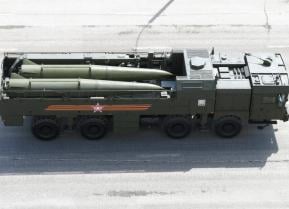The Future of Missile Defense
New technologies for anti-missile defense are challenging the assumed priority of offense over defense.
Policymakers in the Cold War became accustomed to a world in which mutual deterrence was based on a balance of terror, with technology favoring offense over defense. The United States and the Soviet Union invested significant research and development in ballistic missile defenses (BMD) to protect their strategic nuclear retaliatory forces and their respective national territories. In the case of the United States, various missile defense systems were proposed and eventually deployed, such as the ABM (anti-ballistic missile) systems like Safeguard and Sentinel. The ABM Treaty of 1972 limited the U.S. and the Soviet Union to two national missile defense sites each (later amended to one each). However, the George W. Bush administration later pulled out of it. The most ambitious proposal for national missile defense was President Reagan’s Strategic Defense Initiative (SDI) in 1983, although this was never implemented.
After the Cold War, the United States deployed the Ground-Based Missile Defense (GMD) system in Alaska and California for midcourse kinetic intercept of ballistic missile attacks, with some limited capability against light attacks but far short of its ambition of defeating large-scale attacks involving many hundreds or thousands of attacking re-entry vehicles and warheads. Mutual deterrence remained dependent on survivable second-strike offensive weapons deployed for launchers based on land, sea, or air.
New technologies for anti-missile defense are challenging the assumed priority of offense over defense. By the 2030s, new technologies for ballistic missile defense may complicate the assumptions underlying existing strategies for deterring nuclear war, with the future relationship between technology and nuclear strategy being unclear. Defensive technologies may be more competitive than offensive ones, but this welcome attribute involves some complications for strategy and arms control.
Noted scientist and nuclear policy expert Freeman Dyson anticipated passage from a defense-nullified to a defense-assertive technical world. In his classic work Weapons and Hope, published in the 1980s, Dyson called for a “middle way” between what he saw as the dead ends of nuclear counterforce warfighting and assured destruction. Today, his proposed strategic paradigm is a defense-protected build-down of U.S. and Russian strategic nuclear forces: improved defenses combined with shrinking numbers of offensive weapons to pave the way for a world without nuclear weapons entirely.
However, Dyson was also a political realist: he did not expect to get to nuclear zero in one big jump. Instead, his proposal called for gradual reductions in American and Russian offensive weapons in a step-by-step process guarded by improving ballistic missile defenses. He summarized its essentials: a defense-dominant world assumes that we should prefer live Americans to dead Russians instead of basing deterrence on the self-defeating model of guaranteed mutual assured destruction.
It is unnecessary to adopt all of Dyson’s assumptions to see the attractiveness of his basic instincts. After being briefed on the consequences of nuclear war and the essentials of deterrence strategy, President Ronald Reagan was horrified and demanded research and development toward the deployment of improved defense relative to offense. Reagan and Soviet leader Mikhail Gorbachev came close to agreement on doing away entirely with their respective offensive strategic nuclear forces at Reykjavik in 1987 (much to the surprise of their advisors) until Reagan refused Gorbachev’s demand for dismantling the Strategic Defense Initiative (SDI) program.
Some think we are now on the verge of a step-functional improvement in missile defense technology that could bring us closer to Dyson’s world of defense-offense competitiveness instead of the offense-dominant world of the past. One potential explanation is that the correlation of forces in defense-related systems is no longer driven by heavy metal but by advanced software. By the 2030s, it may be possible to develop and deploy defenses exploiting “left of launch” techniques that can destroy ballistic missiles on their launch pads or shortly after liftoff. The technologies that can expedite this mission include directed energy weapons, electronic warfare, autonomous vehicles, and cyber warfare of various sorts.
However, as new technologies ripen for missile defense, the offense will not stand still. We are also headed into an advanced precision strike regime with improved accuracies for weapons of longer ranges, whether nuclear or conventional. Hypersonic weapons will also reduce the time available to defenders for indications and warning, decision-making, and timely response to attack. Some hypersonics will also be equipped with capabilities purposely built to evade defenses, including cruise and ballistic missiles and smart drone swarms.
Both defense and offense will make qualitative leaps in performance due to future advances in enabling technologies: artificial intelligence, quantum computing, and human-machine interfaces. In addition, the future domains for conflict will include competitive technologies for space, cyber deterrence, and warfare. Putative missile attackers will first have to negate or seriously weaken the other side’s space resources and cyber capabilities before attempting a disarming first strike with any hope of success. The interactive complexity of deterrence and war across these domains while exploiting these emerging technologies will challenge the sluggishness of decision-making based on hierarchical bureaucratic “stovepipes” in favor of lightning-speed networks.
There is also the Cheshire Cat effect: offense can become defense, and defense is transformed into offense. Consider the prior example of “left of launch” techniques for prompt disarming and disabling ballistic missiles. If one side has that capability and the other does not, the first side has a de facto first-strike capability. Or take the case of defensive satellites deployed in space to protect a country against an attack on its satellites for intelligence, surveillance, communications, warning, and navigation. If another state’s satellites approach too closely to the first state’s space-based assets and appear ready to conduct a disarming strike, the defender’s satellites (DSATs) might be tasked to strike preemptively at the prospective attacker.
The DSAT preemption might then be interpreted by potential attackers as a prelude to further escalation and prompt a space-based or other response seen as hostile by the state on the receiving end. The cognitive complexity of these examples is exacerbated by the likelihood that systems will not fail comprehensively or all at once but unpredictably and partially. The degree to which systems malfunction in real time may not be apparent before partial degradation is transformed into holistic catastrophe—you don’t know what you don’t know.
The preceding observation brings to the forefront the capabilities of C4ISR (Command, Control, Communications, Computers, Intelligence, Surveillance, and Reconnaissance) systems and their effects on the performances of offensive and defensive systems. Improvements in AI and quantum computing accelerate the rate at which digital systems can acquire information, process data, and generate alternative response patterns for decision-makers. Analysts and policymakers will increasingly depend on brilliant machines, pushing the human-machine interface toward automatic response.
People will always be in the loop, but they are organized into bureaucracies that rely on standard operating procedures and frequently rehearsed scenarios. Adaptive decision-making for nonstandard events, including previously unchoreographed crises and events not yet drilled into institutional memory banks, will default to machines that can provide quick responses at light speed. Another issue is the survivability and endurance of the command-control systems, as attacks on cyber networks and space-based assets can turn the C4ISR systems into spaghetti even before kinetic strikes.
An important and challenging role for future missile defense is the defense of the National Command Authority (NCA.). The NCA is not a building or an installation but a complex web of networks that connects the Presidential Center to the Office of the Secretary of Defense and, thence, to the unified and specified military commanders who operate military forces. This network transduces all potential conflict domains (land, sea, air, space, and cyberspace) and must be survivable against enemy attack. Although U.S. missile defense is only one element among many in carrying out this mission, they are already tasked with regional and nationwide protection of forces and command elements across various domains. The current distribution of missile defense assets complicates the plans of any potential attacker in addition to other uncertainties inherent in nuclear first strikes.
In sum, we are headed for either an offense-dominant, defense-dominant, or offense-defense competitive environment for the remainder of the twenty-first century due in part to the mastery of technology by artificial intelligence, quantum computing, and human-machine interfaces. In addition, the United States has an additional challenge of maintaining its leadership in military research and development relative to possible challengers. We can no longer take for granted the existence of a national culture supportive of academic excellence and depoliticized research. As we move into a more information-driven world, the platitudes of partisanship collide with the necessity for collaboration. Knowledge is essential, but wisdom is even more precious, based on awareness of history and respect for humane values. Wisdom suggests that deterrence is far better than war, and future weapons systems should be evaluated through this lens.
About the Authors:
Lawrence J. Korb is a senior fellow at American Progress and an adjunct professor at Georgetown University. He was previously a senior fellow and director of national security studies at the Council on Foreign Relations.
Stephen J. Cimbala is a distinguished professor of political science at Penn State Brandywine and the author of numerous books and articles on international security studies, defense policy, nuclear weapons and arms control, intelligence, and other fields.


